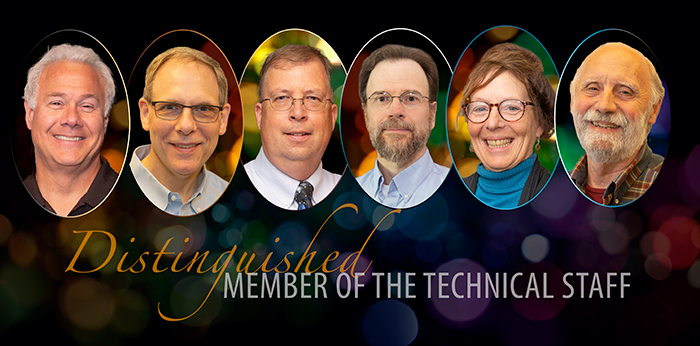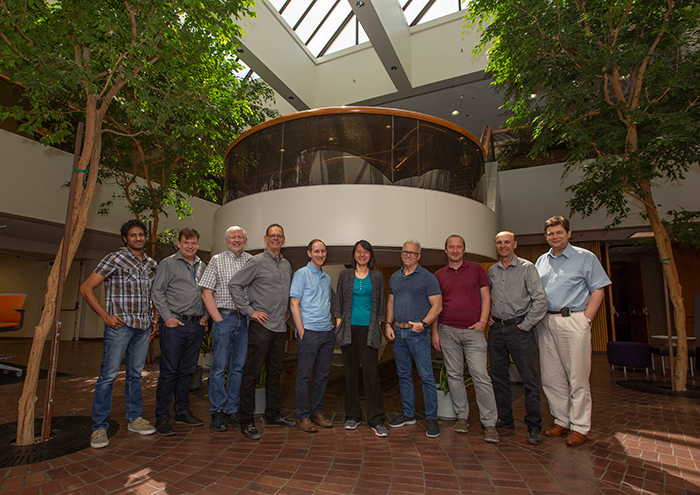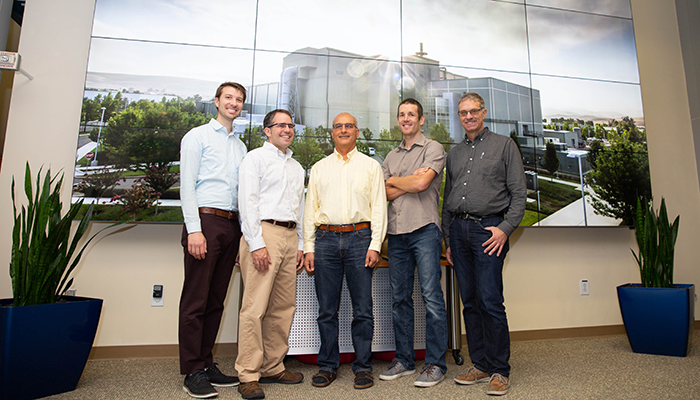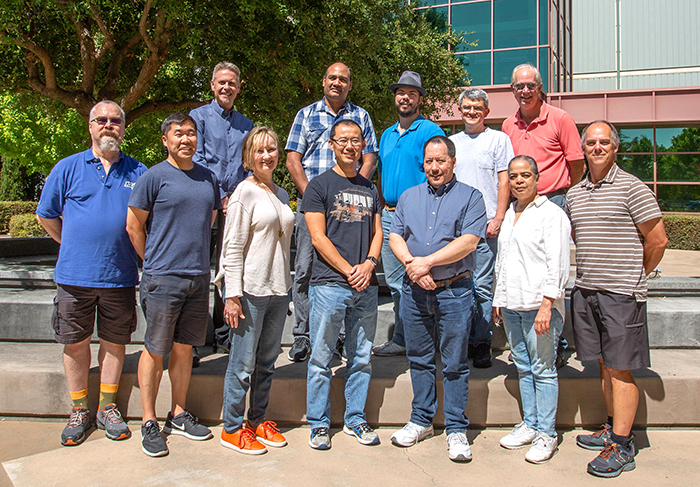NIF&PS Employees Honored With LLNL Awards
October 15, 2019
Several NIF & Photon Science research teams and individuals recently won Lawrence Livermore National Laboratory awards for their career achievements, institutional contributions, and contributions to scientific publications during the past year.
Distinguished Members of Technical Staff
 Christopher Carson, Laurence Fried, Dan Kalantar, Brian Pudliner, Marilyn Schneider, and George Zimmerman have been named Distinguished Members of Technical Staff at LLNL.
Christopher Carson, Laurence Fried, Dan Kalantar, Brian Pudliner, Marilyn Schneider, and George Zimmerman have been named Distinguished Members of Technical Staff at LLNL. Dan Kalantar, Lab senior target area scientist, was one of six LLNL scientists named as Distinguished Members of Technical Staff (DMTS) for extraordinary scientific and technical contributions to the Laboratory and its missions, as acknowledged by their professional peers and the larger community.
It is the highest technical staff level achievable by a scientist or engineer at the Lab.
“I am honored to have been awarded the status of DMTS,” Kalantar said. “It is a recognition that the role I have had developing experimental capabilities is important and valued.”
Kalantar joined the Lab in 1993 as a postdoc in the laser program and became a staff scientist in 1995. He has spent his career at the Lab working in laser programs and NIF.
Kalantar is recognized worldwide as the leading expert in developing and implementing laser-target experiments for high energy density physics. He has a keen ability to integrate complex physics and facility issues to deliver a platform that provides physics results. He published the first experiments establishing that large laser facilities can be used to measure the solid state properties of materials at high pressure.
In addition to his scientific achievements, he has mentored students and early career staff.
The DMTS classification was created to serve as a career ladder for LLNL scientists and engineers within the Science & Engineering (S&E) classification structure. It recognizes outstanding S&T excellence with distinction and compensation while allowing the honored recipients to remain focused on delivering science and engineering solutions to critical mission areas of the Laboratory.
The DMTS designation has also been awarded to:
- Chris Carson of the Global Security Directorate.
- Larry Fried of the Materials Science Division of the Physical and Life Sciences (PLS) Directorate.
- Brian Pudliner of the Weapons and Complex Integration (WCI) Directorate Design Physics Group.
- Marilyn Schneider of the PLS Directorate.
- George Zimmerman of the WCI Design Physics Group.
Deputy Director‘s Science and Technology Excellence in Publication
LLNL Director Bill Goldstein and Deputy Director for Science and Technology Pat Falcone announced the 2019 S&T Excellence in Publication awards have gone to nine staff project teams, four postdocs, and four students for their exceptional endeavors in science and technology.
The awards were first implemented in 2000 to acknowledge and reward outstanding scientific and technical publications by LLNL staff. Publications honored by this award are judged to have an especially significant impact on the external scientific and technical community or important Laboratory missions.
This year’s project team awards included:
Enhanced Energy Coupling for Indirectly Driven Inertial Confinement Fusion
 Members of the Enhanced Energy Coupling Team (from left): Shahab Khan, Andrew MacPhee, Robert Tipton, Peter Amendt, David Strozzi, Yuan Ping, Frank Graziani, Eduard Dewald, Vladimir Smalyuk, and Otto Landen. Credit: Julie Russell
Members of the Enhanced Energy Coupling Team (from left): Shahab Khan, Andrew MacPhee, Robert Tipton, Peter Amendt, David Strozzi, Yuan Ping, Frank Graziani, Eduard Dewald, Vladimir Smalyuk, and Otto Landen. Credit: Julie Russell Published in Nature Physics, the paper detailed how NIF experiments by scientists from Lawrence Livermore and Los Alamos national laboratories using a hohlraum shaped like a rugby ball have significantly boosted the amount of laser-induced energy absorbed by an inertial confinement fusion (ICF) fuel capsule. (See: Rugby Hohlraum Kicks Up NIF’s Energy Efficiency)
The paper was authored by Yuan Ping, Vladimir Smalyuk, Peter Amendt, Riccardo Tommasini, John Field, Shahab Khan, Eduard Dewald, Frank Graziani, Steve Johnson, Otto Landen, Andrew MacPhee, Abbas Nikroo, Jesse Pino, Shon Prisbrey, Joseph Ralph, Richard Seugling, David Strozzi, Robert Tipton, and Yinmin Wang.
Insulator-Metal Transition in Dense Fluid Deuterium
 Insulator-Metal Transition Team members (from left): Jayson Peterson, Nathan Meezan, Peter Celliers, Marius Millot, and Jon Eggert. Credit: Julie Russell
Insulator-Metal Transition Team members (from left): Jayson Peterson, Nathan Meezan, Peter Celliers, Marius Millot, and Jon Eggert. Credit: Julie Russell The paper was authored by Peter Celliers, Marius Millot, Dayne Fratanduono, Jon Eggert, Jayson Peterson, Nathan Meezan, and Sebastien Le Pape and an international team including researchers from CEA, UC Berkeley, the Carnegie Institution in Washington and the University of Edinburgh.
The paper, published in Science and highlighted by the New York Times, detailed how NIF Discovery Science experiments provided exquisite data that allowed the team to reveal “the conditions in which hydrogen disassociates and becomes an atomic metal occur in high energy density environments, such as the interiors of giant planets and nuclear explosions.”
This research was also featured in an episode of the BBC TV show Horizon about what the NASA Juno mission discovered about Jupiter. (To read more, see: NIF Reveals How Hydrogen Becomes Metallic in Giant Planets)
Director’s 2019 Institutional Operational Excellence Awards
In recognition of important employee and team accomplishments that contribute to the successful execution of the Lab's overall missions, the Director's Office presented the annual Institutional Operational Excellence Awards to 120 employees divided between eight teams, including one team recognized for Outstanding Support in Accomplishing Multi-Year NIF Controls Software Modernization.
 Members of the NIF Controls Software Modernization team. Back row (from left): Gordon Brunton, Vinod Gopalan, Adrian Barnes, Mikhail Fedorov, and Arthur Ludwigsen. Front row (from left): Lyle Beaulac, Lei Wang, Suzanna Townsend, Alan Pao, Christopher Estes, Bela Patel, and Michael Flegel. Not pictured: Marty Lewis.
Members of the NIF Controls Software Modernization team. Back row (from left): Gordon Brunton, Vinod Gopalan, Adrian Barnes, Mikhail Fedorov, and Arthur Ludwigsen. Front row (from left): Lyle Beaulac, Lei Wang, Suzanna Townsend, Alan Pao, Christopher Estes, Bela Patel, and Michael Flegel. Not pictured: Marty Lewis. The NIF controls organization realized that the existing software control system was unlikely to remain viable to support NIF operations going forward. Several years ago, the team embarked on an effort to convert the entire control system, including four million lines of code and hardware, to a more modern foundation, ensuring continued support for the NIF experiments in the years to come.
The team included Adrian Barnes, Lyle Beaulac, Gordon Brunton, Christopher Estes, Mikhail Fedorov, Michael Flegel, Vinod Gopalan, Marty Lewis, Arthur Ludwigsen, Alan Pao, Bela Patel, Suzanna Townsend, and Lei Wang.
—Follow us on Twitter: @lasers_llnl



